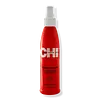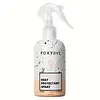What's inside
What's inside
 Key Ingredients
Key Ingredients

No key ingredients
 Benefits
Benefits

 Concerns
Concerns

 Ingredients Side-by-side
Ingredients Side-by-side

Water
Skin ConditioningSodium Polystyrene Sulfonate
Emulsion StabilisingAlcohol Denat.
AntimicrobialPropanediol
SolventPolysorbate 20
EmulsifyingHydrolyzed Silk
HumectantPhenoxyethanol
PreservativeCaprylyl Glycol
EmollientHexylene Glycol
EmulsifyingPotassium Sorbate
PreservativeHydrolyzed Wheat Protein Pg-Propyl Silanetriol
Skin ConditioningPPG-20 Methyl Glucose Ether
Skin ConditioningParfum
MaskingBenzyl Benzoate
AntimicrobialButylphenyl Methylpropional
PerfumingHydroxyisohexyl 3-Cyclohexene Carboxaldehyde
MaskingHexyl Cinnamal
PerfumingSilica
AbrasiveAlumina
AbrasiveTitanium Dioxide
Cosmetic ColorantCitric Acid
BufferingWater, Sodium Polystyrene Sulfonate, Alcohol Denat., Propanediol, Polysorbate 20, Hydrolyzed Silk, Phenoxyethanol, Caprylyl Glycol, Hexylene Glycol, Potassium Sorbate, Hydrolyzed Wheat Protein Pg-Propyl Silanetriol, PPG-20 Methyl Glucose Ether, Parfum, Benzyl Benzoate, Butylphenyl Methylpropional, Hydroxyisohexyl 3-Cyclohexene Carboxaldehyde, Hexyl Cinnamal, Silica, Alumina, Titanium Dioxide, Citric Acid
Water
Skin ConditioningTrimethylolpropane Tricaprylate/Tricaprate
EmollientGlycerin
HumectantCetearyl Alcohol
EmollientCeteareth-20
CleansingGlyceryl Stearate
EmollientPEG-100 Stearate
Steareth-2
EmulsifyingDimethicone
EmollientCeteth-24
CleansingPhospholipids
Skin ConditioningPhenoxyethanol
PreservativeCaprylyl Glycol
EmollientChlorphenesin
AntimicrobialCetrimonium Chloride
AntimicrobialHydroxypropyltrimonium Hydrolyzed Soy Protein
Skin ConditioningSilicone Quaternium-16
Skin ConditioningUndeceth-11
EmollientButyloctanol
HumectantUndeceth-5
EmulsifyingAmodimethicone
Trideceth-12
EmulsifyingKeratin
Skin ConditioningHydrolyzed Keratin
HumectantPropylene Glycol
HumectantHexylene Glycol
EmulsifyingPEG-12 Dimethicone
Skin ConditioningBiotin
AntiseborrhoeicParfum
MaskingPolyquaternium-53
Helianthus Annuus Seed Oil
EmollientCitric Acid
BufferingHexyl Cinnamal
PerfumingButylphenyl Methylpropional
PerfumingLimonene
PerfumingCoumarin
PerfumingLinalool
PerfumingBenzyl Benzoate
AntimicrobialAnise Alcohol
PerfumingCitral
PerfumingCitronellol
PerfumingGeraniol
PerfumingWater, Trimethylolpropane Tricaprylate/Tricaprate, Glycerin, Cetearyl Alcohol, Ceteareth-20, Glyceryl Stearate, PEG-100 Stearate, Steareth-2, Dimethicone, Ceteth-24, Phospholipids, Phenoxyethanol, Caprylyl Glycol, Chlorphenesin, Cetrimonium Chloride, Hydroxypropyltrimonium Hydrolyzed Soy Protein, Silicone Quaternium-16, Undeceth-11, Butyloctanol, Undeceth-5, Amodimethicone, Trideceth-12, Keratin, Hydrolyzed Keratin, Propylene Glycol, Hexylene Glycol, PEG-12 Dimethicone, Biotin, Parfum, Polyquaternium-53, Helianthus Annuus Seed Oil, Citric Acid, Hexyl Cinnamal, Butylphenyl Methylpropional, Limonene, Coumarin, Linalool, Benzyl Benzoate, Anise Alcohol, Citral, Citronellol, Geraniol
Ingredients Explained
These ingredients are found in both products.
Ingredients higher up in an ingredient list are typically present in a larger amount.
Benzyl Benzoate is usually created from the condensation of benzoic acid and benzyl alcohol. It is used as a preservative, solvent, and has a floral/balsamic scent in large amounts.
As a preservative, Benzyl Benzoate works against bacteria and fungus. It is often used to treat scabies and lice in medicine.
Solvents are used to keep ingredients together in a product. They can help dissolve ingredients to stable bases or help evenly distribute ingredients throughout the product.
Due to its fragrance, Benzyl Benzoate can be sensitizing and may cause contact dermatitis. It is a known EU allergen. We recommend speaking with a professional if you have any concerns.
Benzyl Benzoate can be naturally found in cranberries and peaches.
Learn more about Benzyl BenzoateButylphenyl Methylpropional is a synthetic fragrance. You might know it as "lilial". The scent of this ingredient is floral-like and similar to the scent of lily flowers.
In March of 2022, the EU banned this ingredient in both rinse-off and leave-on products. This is because research found Butylphenyl Methylpropional to disrupt fertility in rats.
This ingredient is also a known EU allergen, meaning it is likely to cause an allergic reaction. Irritated skin can be damaging.
We always recommend speaking with a professional if you have any concerns or questions about this ingredient.
Learn more about Butylphenyl MethylpropionalCaprylyl Glycol is a humectant and emollient, meaning it attracts and preserves moisture.
It is a common ingredient in many products, especially those designed to hydrate skin. The primary benefits are retaining moisture, skin softening, and promoting a healthy skin barrier.
Though Caprylyl Glycol is an alcohol derived from fatty acids, it is not the kind that can dry out skin.
This ingredient is also used as a preservative to extend the life of products. It has slight antimicrobial properties.
Learn more about Caprylyl GlycolCitric Acid is an alpha hydroxy acid (AHA) naturally found in citrus fruits like oranges, lemons, and limes.
Like other AHAs, citric acid can exfoliate skin by breaking down the bonds that hold dead skin cells together. This helps reveal smoother and brighter skin underneath.
However, this exfoliating effect only happens at high concentrations (20%) which can be hard to find in cosmetic products.
Due to this, citric acid is usually included in small amounts as a pH adjuster. This helps keep products slightly more acidic and compatible with skin's natural pH.
In skincare formulas, citric acid can:
While it can provide some skin benefits, research shows lactic acid and glycolic acid are generally more effective and less irritating exfoliants.
Most citric acid used in skincare today is made by fermenting sugars (usually from molasses). This synthetic version is identical to the natural citrus form but easier to stabilize and use in formulations.
Read more about some other popular AHA's here:
Learn more about Citric AcidHexyl Cinnamal is a fragrance ingredient with a similar scent to jasmine. It can be naturally found in chamomile essential oil.
This ingredient is a known EU allergen and may sensitize the skin. The EU requires this ingredient to be listed separately on an ingredients list.
Hexyl Cinnamal is not water soluble but is soluble in oils.
Learn more about Hexyl CinnamalHexylene Glycol is a surfactant. Glycols are a class of alcohols. Hexylene Glycol is a surfactant and emulsifier.
As a surfactant, Hexylene Glycol helps gather dirt and oil on your skin to be washed away.
As an emulsifier, Hexylene Glycol helps keep water and oil together. This prevents them from separating in a product. Hexylene Glycol also thins out the texture of a product by lessening viscosity.
Hexylene Glycol has a small molecular weight.
Learn more about Hexylene GlycolParfum is a catch-all term for an ingredient or more that is used to give a scent to products.
Also called "fragrance", this ingredient can be a blend of hundreds of chemicals or plant oils. This means every product with "fragrance" or "parfum" in the ingredients list is a different mixture.
For instance, Habanolide is a proprietary trade name for a specific aroma chemical. When used as a fragrance ingredient in cosmetics, most aroma chemicals fall under the broad labeling category of “FRAGRANCE” or “PARFUM” according to EU and US regulations.
The term 'parfum' or 'fragrance' is not regulated in many countries. In many cases, it is up to the brand to define this term.
For instance, many brands choose to label themselves as "fragrance-free" because they are not using synthetic fragrances. However, their products may still contain ingredients such as essential oils that are considered a fragrance by INCI standards.
One example is Calendula flower extract. Calendula is an essential oil that still imparts a scent or 'fragrance'.
Depending on the blend, the ingredients in the mixture can cause allergies and sensitivities on the skin. Some ingredients that are known EU allergens include linalool and citronellol.
Parfum can also be used to mask or cover an unpleasant scent.
The bottom line is: not all fragrances/parfum/ingredients are created equally. If you are worried about fragrances, we recommend taking a closer look at an ingredient. And of course, we always recommend speaking with a professional.
Learn more about ParfumPhenoxyethanol is a preservative that has germicide, antimicrobial, and aromatic properties. Studies show that phenoxyethanol can prevent microbial growth. By itself, it has a scent that is similar to that of a rose.
It's often used in formulations along with Caprylyl Glycol to preserve the shelf life of products.
Water. It's the most common cosmetic ingredient of all. You'll usually see it at the top of ingredient lists, meaning that it makes up the largest part of the product.
So why is it so popular? Water most often acts as a solvent - this means that it helps dissolve other ingredients into the formulation.
You'll also recognize water as that liquid we all need to stay alive. If you see this, drink a glass of water. Stay hydrated!
Learn more about Water